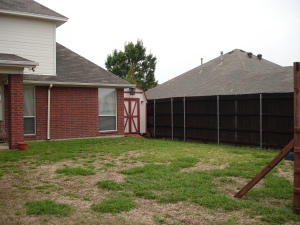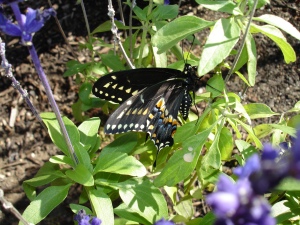Inspired by sites like urbanhomestead.org and the book “Square Foot Gardening” by Mel Bartholomew, our family has decided to see what we can grow in one small section of our backyard in Collin County, Texas (north of Dallas).
We have very little experience as gardeners. We thought it would be fun and informative to document our journey with this blog.
First a little on our backyard and what we started with.
Our house has a southern exposure. Our backyard is basically square, with a garage wall running along the eastern edge, a patio in the south-eastern corner and a playground in the north-western corner. We have a large trampoline that takes up a little less than 1/3 the width of the backyard, and a little less than a quarter of the available open space. Here's a satellite photo of our backyard before any improvements (photo is facing south):

When we moved into our house in November of 2006, our backyard was a shambles. There wasn't anything other than a jungle gym and half-dead grass (with St. Augustine grass competing for dominance with Bermuda grass).
This is what our lawn looked like when we moved in:

Over the next two years we slowly nurtured the lawn back. In the summertime, when the lawn isn't dormant, the St. Augustine has basically been resurrected to cover the entire backyard. Not too long after we moved in, my father-in-law and I built a sandbox that now sits next to the patio and the back wall of the house.
Two years ago we decided to plant some trees in the yard. We planted a cherry (we didn't think it would last, but wanted to try), a Bradford Pear and a peach along the western fence line and a Fuji Apple in the northeast corner. The cherry didn't make it through the first summer. The peach made it a year and then died in the middle of last summer.
Last spring we decided to try to grow more than grass in the backyard. We removed a rounded corner of sod in the northeast corner of the yard (bottom left of the picture above, the Apple tree is in the middle of this area) and about a five foot-wide strip along the western fence (the right side of the picture above).
I started removing the sod myself and quickly learned how difficult it is. We hired our lawn service company to finish the job. Unfortunately, we didn't hire them to haul away the sod, thinking that we could dispose of it over time in our recycle bin. That was a bad idea.
Eventually, we borrowed a friend's truck and hauled a whole truck load of sod to the dump. That was a HUGE pain - literally. If you decide to remove sod from your yard, and can afford to hire someone to rip it out for you, make sure you also hire them to haul the sod away.
The plan was to plant a flower garden in the rounded corner garden (the "Flower Garden") and a vegetable garden in the strip of ground along the western fence (the "Strip Garden"). We borrowed a friend's truck and brought in several cubic yards of compost which we mixed into the soil in the Flower Garden and the Strip Garden.
We planted a blackberry bush and some strawberry plants in the northern corner of the Strip Garden and 4 or 5 tomato plants along the rest of the Strip Garden. We also planted climbing roses and various other flowering in the Flower Garden.
Here's what our Flower Garden looked like last summer:

The blackberry and strawberry plants did alright, but the clay soil did not work for the tomatoes. They suffered all summer long. This experience made us realize that Texas clay soil is not conducive to vegetable gardens, and that we weren't prepared to spend the time, energy and money necessary to bring our existing soil up to snuff.
That's when we found the two resources listed above and decided to give raised bed gardening a try.








